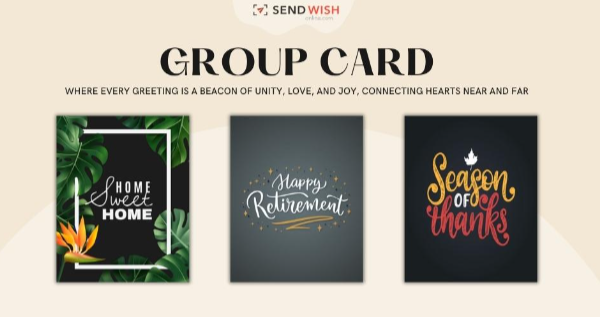It gives a slightly different feeling when instead of receiving another e-mail or even a card
with a digital greeting, a person receives a card meant to be handwritten and filled with kind
words from a group of people. Whatever the occasion will be, whether it is a celebration of a
certain achievement, thanking someone or even just a sign of support, group cards remain
relevant in expressing gratitude in modern society. This article aims to discuss the
philosophy behind group cards in an attempt to uncover why appreciation in the form of
group cards is deemed to be ideal, investigate their potential to elicit feelings and create a
deeper level of meaning in card-giving and receiving, as well as to discover why even in
today’s highly technological world, group cards continue to come to the fore both in general
and in specific contexts.
Collective Expression of Gratitude
Arguably, one of the biggest benefits of group cards is that when people select them in call,
it consolidates the thoughts of many people into one physical symbol of appreciation.
Compared to single cards that are amazing in their own way, a group card can provide
people who are co-workers, friends, relatives or simply fellow members of the community an
opportunity to support and salute someone and do so together.
Think about a retiree who receives an open space card with various colleagues writing brief
notes of encouragement, or a similar case with a student who compiles messages from
classmates on a birthday card. These collective efforts enhance the feelings of appreciation
that the recipient will have since it demonstrates that he or she made an impact and
contributed towards the lives of many people.
Emotional Connection and Warmth
Writing something with a pen on paper in a group card is more emotional compared to even
an actual typing on a Smartphone. Every notation, autograph, or sketch invests the recipient
with the touch of human warmth and attention. Specifically, penning a message on paper
focuses one’s energy on the act of writing and hence the message given on the card
appears more sincere as well as warmer.
Group cards are common in professional circles especially in workplaces since they help
create a unity of workers. It means that the recipient’s effort is not only appreciated by one
person but it also symbolizes that everyone under that group is acknowledging the efforts
and work of that person. Such an emotional bond fosters family-like notions in the
workplace, thus encouraging collective motivation and support.
Keepsake Value and Longevity
This, in contrast, to other pervasive forms of communication such as emails or text
messages, which are easily lost within the noise of digital communication. They represent a
physical touch point to significant occurrences in life and its undertakings. These cards are
utilised in times of retrospection or anytime one wishes to recap events or situations and are
often kept for many years.
Group cards can be carried for months, or even years, meaning theirmessages can be felt
long after the card is handed over. These are likely to remain little keepsakes which people
hold dear to their hearts and disseminate joy and comfort even years after being shared.
These cards may lie on the desk, be on the wall or simply be placed in a memory box but
they do not lose their importance or receive the same feelings of the appreciation as was
expressed out.
Personalization and Thoughtfulness
The fact that the participants get to carve out a message before composing the group card
familiarizes it with the receiver and formulates the correspondent card depending on the
relation with the receiver. It also entails a sense of unity, since contributors do not simply
type a few words in a rush, but rather find time to type a few touching words that relate with
the next person’s personality, accomplishment or characteristic.
Receiving a card, for instance, through a group reading , becomes the finding the journey as
the audience feels every ranging from humor to sadness as the card instills feelings inspired
by the strings touching card statements. Everything that the recipient is as a person is also
encompassed in every message and, together, they weave a beautiful mosaic of gratitude
acknowledging the role this person plays in the lives of others.
Versatility Across Various Occasions
As you can imagine, group cards are very universal, and you can invite friends to celebrate
anything – achievement or simply a desire to spend time with friends. From birthdays and
anniversaries to retirements, promotions, graduations, and farewells, it meets all situations
whilst maintaining its capacity to offer thanks and support.
As for group cards, such cards are popular among students and teachers to say ‘thank you’
in the case learning and teaching, or to wish good-bye to a liked teacher, for example, at the
end of the school year. In the community organizations they act as a symbol of appreciation
to the volunteers or some contributors who has been of great help to the society through
their diligence.
Conclusion
That is the basic thought of group cards – to combine the spirit of togetherness and the act
of appreciating each other in the material world. In this current generation of technology,
they go beyond as they are the means of having small and warm gestures of expressing
word of appreciation, accomplishment, and encouragement. These cards are of course
useful in business and office, they can also be applied in day to day interactions, and in
friendships or relations, which makes them timeless presents.
When the days and hours are filled with messages, which sometimes seem all boring, group
cards are seen as very personal and full of warm regards. Here, we are receiving a small
reminder of how society needs to be united and pause from the current state of technological
advances to pick up a piece of paper with a few hand-written words of gratitude from a
stranger. Therefore, group cards continue to remain a perfect mean or, in fact, the only
meaningful way of expressing gratitude in the contemporary world interconnected yet
frequently cold.








